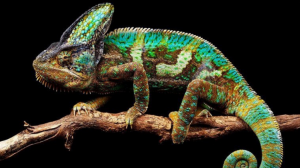
Communicating in Colour
There are more than 160 known species of chameleons. The main distribution is in Africa and Madagascar, and other tropical regions, although some species are also found in parts of southern Europe and Asia. There are introduced populations in Hawaii and probably in California and Florida too.
New species are still discovered quite frequently. Dr Andrew Marshall, a conservationist from York University, was surveying monkeys in Tanzania, when he stumbled across a twig snake in the Magombera forest which, frightened, coughed up a chameleon and fled. Though a colleague persuaded him not to touch it because of the risk from venom, Marshall suspected it might be a new species, and took a photograph to send to colleagues, who confirmed his suspicions. Kinyongia magomberae, literally “the chameleon from Magombera”, is the result, and the fact it was not easy to identify is precisely what made it unique. The most remarkable feature of chameleons is their ability to change colour, an ability rivalled only by cuttlefish and octopi in the animal kingdom. Because of this, colour is not the best thing for telling chameleons apart and different species are usually identified based on the patterning and shape of the head, and the arrangement of scales. In this case it was the bulge of scales on the chameleon’s nose.
Chameleons are able to use colour for both communication and camouflage by switching from bright, showy colours to the exact colour of a twig within seconds. They show an extraordinary range of colours, from nearly black to bright blues, oranges, pinks and greens, even several at once. A popular misconception is that chameleons can match whatever background they arc placed on, whether a chequered red and yellow shirt or a Smartie* box. But each species has a characteristic set of cells containing pigment distributed over their bodies in a specific pattern, which determines the range of colours and patterns they can show. To the great disappointment of many children, placing a chameleon on a Smartie box generally results in a stressed, confused, dark grey or mottled chameleon.
Chameleons are visual animals with excellent eyesight, and they communicate with colour. When two male dwarf chameleons encounter each other, each shows its brightest colours. They puff out their throats and present themselves sidc-on with their bodies flattened to appear as large as possible and to show off their colours. This enables them to assess each other from a distance. If one is clearly superior, the other quickly changes to submissive colouration, which is usually a dull combination of greys or browns. If the opponents are closely matched and both maintain their bright colours, the contest can escalate to physical fighting and jaw-locking, each trying to push each other along the branch in a contest of strength. Eventually, the loser will signal his defeat with submissive colouration.
Females also have aggressive displays used to repel male attempts at courtship. When courting a female, males display the same bright colours that they use during contests. Most of the time, females are unreceptive and aggressively reject males by displaying a contrasting light and dark colour pattern, with their mouths open and moving their bodies rapidly from side to side. If the male continues to court a female, she often chases and bites him until he retreats. The range of colour- change during female displays, although impressive, is not as great as that shown by males.
Many people assume that colour change evolved to enable chameleons to match a greater variety of backgrounds in their environment. If this was the case, then the ability of chameleons to change colour should be associated with the range of background colours in the chameleon’s habitat, but there is no evidence for such a pattern. For example, forest habitats might have a greater range of brown and green background colours than grasslands, so forest-dwelling species might be expected to have greater powers of colour change. Instead, the males whose display colours are the most eye-catching show the greatest colour change. Their displays are composed of colours that contrast highly with each other as well as with the background vegetation. This suggests that the species that evolved the most impressive capacities for colour change did so to enable them to intimidate rivals or attract mates rather than to facilitate camouflage.
How do we know that chameleon display colours are eye-catching to another chameleon – or, for that matter, to a predatory bird? Getting a view from the perspective of chameleons or their bird predators requires information on the chameleon s or bird’s visual system and an understanding of how their brains might process visual information. This is because the perceived colour of an object depends as much on die brain’s wiring as on the physical properties of the object itself. Luckily, recent scientific advances have made it possible to obtain such measurements in the field, and information on visual systems of a variety of animals is becoming increasingly available.
The spectacular diversity of colours and ornaments in nature has inspired biologists for centuries. But if we want to understand the function and evolution of animal colour patterns, we need to know how they are perceived by the animals themselves – or their predators. After all, camouflage and conspicuousness are in the eye of the beholder.
*SmartiesTM are sugar-coated chocolates in a range of bright colours.